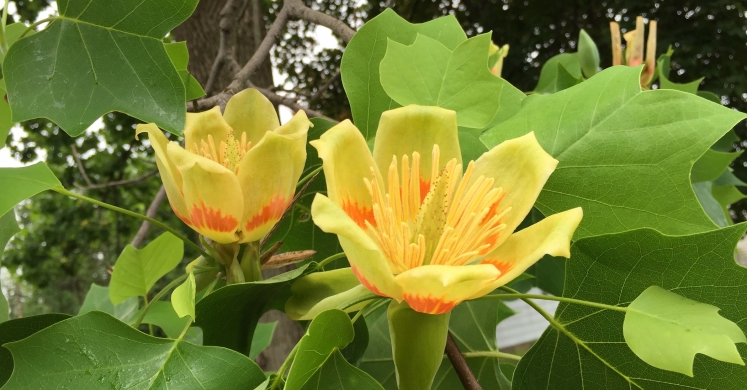Blog

#bioPGH Blog: Tulip Poplar
 A resource of Biophilia: Pittsburgh, #bioPGH is a weekly blog and social media series that aims to encourage both children and adults to reconnect with nature and enjoy what each of our distinctive seasons has to offer.
A resource of Biophilia: Pittsburgh, #bioPGH is a weekly blog and social media series that aims to encourage both children and adults to reconnect with nature and enjoy what each of our distinctive seasons has to offer.
The tulip poplar, also known as a tulip tree or yellow poplar, is an etymological quandary. It’s neither a tulip (family Liliaceae) nor a poplar (Family Salicaceae), and it’s not even related to the African tulip tree (family Bignoniaceae)! Rather, it is actually a magnolia, family Magnoliaceae! The name probably originated with early settlers to North America who noted the resemblance of the tree’s flowers to the tulips that were popular in European gardens. More than just a pretty flower, though, in early America tulip poplars were a popular choice for railroads because of their straight trunks and large size. Today, tulip poplars are a common choice in eastern North America for reforestation projects because of their rapid growth. Let’s check out these tricky-named trees!
Tulip poplars are among the tallest trees in eastern hardwood forests. They can reach over 150 feet tall, and are rapidly growing trees—they can grow roughly two feet per year. The tallest known tulip poplar, aptly named Tall One, grows in a North Carolina stretch of the Smoky Mountains. In addition to its height, the tulip poplar’s foliage and branching can even spread out in a 40-foot diameter, providing ample shade below them. Because they become so large though (with large roots and an abundance of leaves in the fall), they aren’t necessarily suitable for all city and neighborhood settings, but there is cultivar that only grows to roughly 50 feet tall.
As a member of the magnolia family, tulip poplars live up to the expectation of hallmark showy flowers, but the flowers can often be difficult to see. Flowers tend to bloom higher up in the trees, and since they bloom in May and June, the tree’s foliage can partially hide some of the flowers. Even if we have a harder time seeing them, though, the flowers can attract hummingbirds and other pollinators! Later in the summer, both the fruits and seeds from the flowers later provide food for a variety of wildlife such as squirrels, rabbits, and birds.
Connecting to the Outdoors Tip: Tulip poplars are present in a number of Pittsburgh’s parks, but for the best time in our area to see them in flower, keep an eye open in late May or early June.
Continue the Conversation: Share your nature discoveries with our community by posting to Twitter and Instagram with hashtag #bioPGH, and R.S.V.P. to attend our next Biophilia: Pittsburgh meeting.
Resources
USDA Plant Fact Sheet—Tulip Poplar
Longwood Gardens—Giants Among Us
Arbor Day Foundation—Tuliptree
Photo Credits: Wikimedia User High Contrast CC-BY-SA-2.0-DE, and Wikimedia User Famartin CC-BY-SA-4.0

